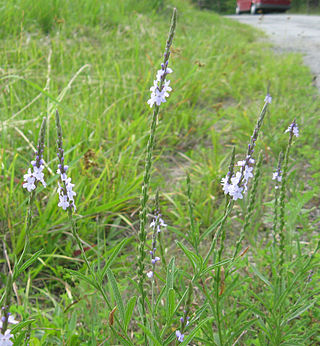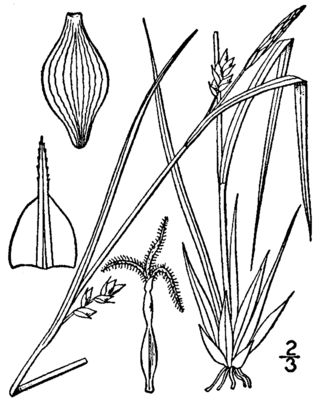
Vaccinium myrtilloides is a shrub with common names including common blueberry, velvetleaf huckleberry, velvetleaf blueberry, Canadian blueberry, and sourtop blueberry. It is common in much of North America, reported from all 10 Canadian provinces plus Nunavut and Northwest Territories, as well as from the northeastern and Great Lakes states in the United States. It is also known to occur in Montana and Washington.

Viburnum nudum is a deciduous shrub in the genus Viburnum within the muskroot family, Adoxaceae.

Eleocharis quinqueflora is a species of spikesedge known by the common names fewflower spikerush and few-flowered spike-rush. It is widespread across Europe, North Africa, northern Asia, and North America. There are also isolated populations in Argentina and Chile.
Eleocharis halophila, the saltmarsh spikerush, is a perennial halophytic plant endemic to salt marshes in eastern Canada, in Ontario in Hudson Bay and James Bay, Quebec in the St. Lawrence Seaway as far as the city of Quebec, Newfoundland and Nova Scotia and in the United States from Maine to North Carolina. It is one of 76 species of Eleocharis amongst the 36 genera in the sedge family (Cyperaceae).

Gaultheria hispidula, commonly known as the creeping snowberry or moxie-plum, and known to Micmaq tribes of Newfoundland as Manna Teaberry, is a perennial spreading ground-level vine of the heath family Ericaceae. It is native to North America and produces small white edible berries. It fruits from August to September. Its leaves and berries taste and smell like wintergreen.

Verbena simplex, commonly known as narrowleaf vervain, is a perennial herbaceous plant plant in the Verbenaceae (vervain) family. It is native to central and eastern North America where it is found in open, dry, habitats on calcareous soil. It produces lavender flowers in the summer.

Agastache scrophulariifolia, also known as the purple giant hyssop, is a perennial plant that grows throughout the US and Northern Ontario, CN. Its name comes from the similarity of its leaves to plants of the genus Scrophularia. It is a beneficial plant to pollinators and is noted for its medicinal properties, as many plants in the mint family are. It tends to grow in disturbed or open areas where it does not have to interact with non-native competitive plants.

Trichophorum cespitosum, commonly known as deergrass or tufted bulrush, is a species of flowering plant in the sedge family. It was originally described by the Swedish naturalist Carl Linnaeus in 1753 as Scirpus cespitosus, but was transferred to the genus Trichophorum by the Swedish botanist Carl Johan Hartman in 1849, becoming Trichophorum cespitosum.

Asclepias variegata, commonly called the redring milkweed or white milkweed, is a plant in the family Apocynaceae. It is native to eastern North America, where it is found in Canada and the United States. It is most common in the Southeastern United States, and becomes rare in the northern edge of its range.

Atriplex glabriuscula, common names Scotland orache, smooth orache, Babington's orache or seaside orach is an Atriplex species native to North America and northern Europe. It is an annual.

Juncus debilis, the weak rush, is a plant indigenous to the United States. It is listed as endangered in Massachusetts and New York, and as threatened in Rhode Island. It is listed as a species of special concern in Connecticut and believed extirpated in that state.

Gamochaeta purpurea, the purple cudweed, purple everlasting, or spoonleaf purple everlasting, is a plant native to North America.

Carex oligocarpa, common name richwoods sedge, eastern few-fruited sedge, few-fruit sedge, and few-fruited sedge is a Carex species that is native to North America. It is a perennial.

Carex oligosperma, common name fewseed sedge, few-seeded sedge, and few-fruited sedge, is a perennial plant in the Carex genus. A distinct variety, Carex oligosperma var. oligosperma, exists.

Cuscuta coryli, synonym Grammica coryli, common name hazel dodder, is a perennial plant in the Cuscutaceae family native to North America.

Lipocarpha micrantha, known as dwarf bulrush, small-flowered hemicarpha, small-flower halfchaff sedge, common hemicarpa and tiny-flowered sedge, is a species of flowering plant in the sedge family (Cyperaceae) native to North America.

Rhynchospora scirpoides, also referred to as Psilocarya scirpoides; common names long-beaked beaksedge and long-beaked bald rush; is a plant in the Rhynchospora genus found in North America.

Schoenoplectus torreyi, common name Torrey bulrush or Torrey's bulrush, is a species of Schoenoplectus found in North America.

Ludwigia polycarpa, common names many-fruited false-loosestrife and false loosestrife seedbox, is a plant found in North America. It is listed as a special concern and believed extirpated in Connecticut, and as endangered in Massachusetts, Pennsylvania and Vermont.

Ludwigia sphaerocarpa, common names globe-fruited false-loosestrife, globefruit primrose-willow, round-fruited false-loosestrife, globe-fruited seedbox, globe-fruited ludwigia, spherical-fruited seedbox and round-fruited false loosestrife; is a plant found in North America. It is listed as endangered in Connecticut, Indiana, Massachusetts and Rhode Island, and as threatened in Michigan and New York (state). It is listed as extirpated in Pennsylvania.



















